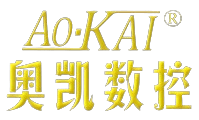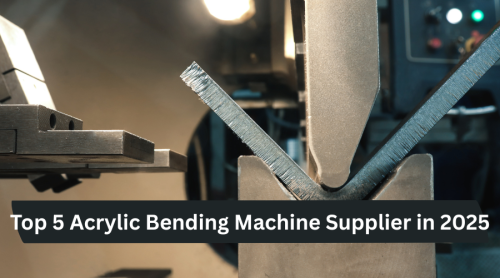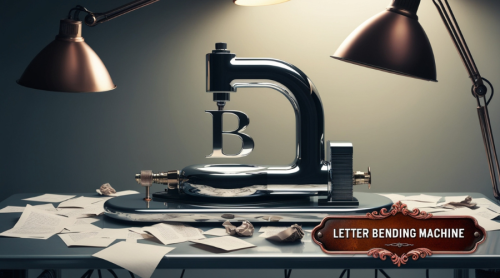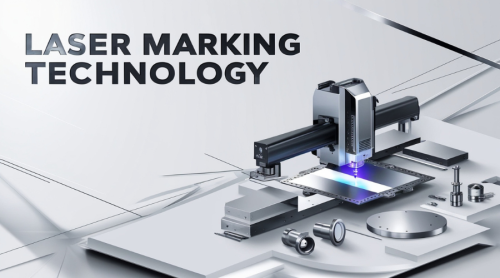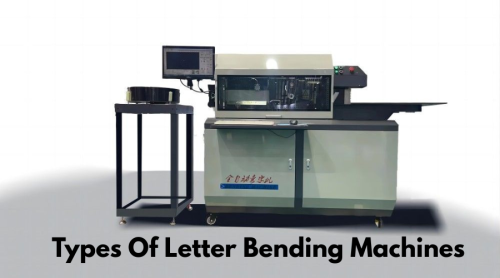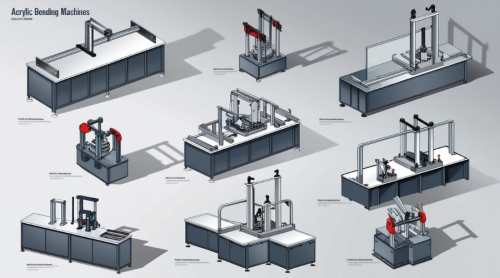.jpg)
Blogs
A Comprehensive Guide to Shaping Plexiglass
Acrylic, also known as plexiglass, offers various applications. Perhaps the best thing is that it’s clear and an easy, safe material to hold. It’s particularly beneficial that you can make ceramics take any form you can imagine. You could achieve beautiful results by knowing how to bend acrylic, no matter if you’re creating something yourself or working professionally. Many people believe that bending acrylic requires specialized tools and extensive practice. Once you know the basics and have some simple tools, anyone can shape plexiglass at home. You need to be aware of how heat affects your material and ensure you do things the right way to achieve consistently excellent results. Choosing the Right Method to Heat Your Project The method for heating acrylic for bending depends on the desired bend. When bending in a straight line, you get the most control with a strip heater. You place the bend line of the acrylic over the heater so that it is above the heating element. Heating softens just where you plan to bend, which makes the rest of the sheet easier to work with. • Heat Gun Technique: Easiness and Precision Heating complex shapes or larger spots is made easier with a heat gun. Keep moving the heat gun to avoid creating spots that could damage the acrylic. Perform your movements smoothly and periodically check your flexibility by applying gentle pressure to assess your range of motion. • Oven Method: Works Best on Complex Curves Forming complex curves and making the entire piece flexible are the reasons oven heating is proper. Cover the acrylic with aluminum foil to prevent direct heat and overheating. Preheat your oven to approximately 200 degrees F, doing so slowly. While it requires patience, making your piece this way allows you to work on it more once it is hot. • Alternative Ways to Clean: Hot Water and Others Several crafters report that hot water baths are effective for thin acrylic sheets. It's a safer method, but it’s only suitable for thin materials and those with effortless bends. Understand the Process: How to Bend Step by Step You need to be patient and ready before bending acrylic successfully. Figure out your bend in detail before you attempt to heat anything. Make your bend lines easy to see, and get all your tools for forming the metal set aside. You must work quickly after the acrylic is heated, so it's essential to be well-organized. Being prepared is very important. Ensure that you clean your acrylic before proceeding with any other steps. Any dirt or fingerprints may weaken the plastic when being heated. If your acrylic includes a protective film, remove it before you start – it can become stuck to your material if heated. How to Heat and Decide on the Right Temperature Always place the bend line over the strip heater during heating. Each millimeter of acrylic usually takes 3-5 minutes to heat. Slow down if you’re using a thicker piece instead of turning up the temperature. • The crucial stage: Starting to make the bend See how flexible the sheet is by trying to raise just one end. If the acrylic has set, you’ll notice it can bend readily with little effort. If you notice any tension, continue practicing and avoid rushing. If you hurry this process, you may end up with stress cracks, or your piece will be unevenly bent. • Shaping and Cooling: How to Create Your Shape Once you are ready, remove the material from the flame and place it on the forming tool immediately. If you want to bend at a 90-degree angle, a wooden block is the best option. Gently and steadily push down the whole time – don’t apply firm pressure. With a bit of pressure, the heated acrylic should bend easily. Keep your shape in place for at least half a minute to allow it to begin cooling. With thicker pieces, you may need to maintain your pressure for a slightly more extended period. As soon as the sculpture is incredible, remove your forming tools. Solving Typical Problems with Bending Sometimes, no matter how much advance work you do, events can still go wrong. Beginners usually encounter stress cracks as their biggest issue. These accidents often occur when the acrylic isn’t hot enough or when excessive pressure is applied during bending. Most minor stress cracks are likely to disappear if you gently rewarm the area and cool it slowly. • Correcting Bends That Are Not Perfect Uneven heating is the main reason for uneven bends. That’s why you should keep your heat source in motion at all times. If your bend line is wavy, often you can fix it by reheating and using a straight guide to help. • Facing Damage from Overheating Acrylic becomes cloudy or develops bubbles when overheated. It’s safer to use a gentler heat setting and a longer duration, so it's best to avoid using higher settings. If something is overheated, sometimes a calm and easy reheat, followed by a slow cool, can improve its appearance. • Understanding What Causes Stress White areas along the bend at sharp corners are usual, but they shouldn’t be seen on gentle curves. Whenever you notice this problem on circles, use a bigger forming tool or heat the whole area of the acrylic. Advanced Ways to Shape Behavior After you learn the basics of bending, it’s time to try some more complex shapes. Compound curves must be shaped quickly after heating a broad section of the acrylic so it doesn’t cool. In these cases, having someone else help you can make things much more straightforward. • Building Cylindrical Shapes You can wrap heated acrylic around a pipe or tube that is the same diameter as the cylindrical shape. Allow for a little less space than you want in your final mold, as the acrylic will shrink slightly as it cools. • Making a Piece with Multiple Bends Making many bends in one piece requires careful planning and is typically accomplished in several steps. Begin with the most challenging bends that require the most heat, and complete the easier ones last. Keeping You and Your Workspace Safe Take some safety measures when using heated acrylic. Wear safety glasses when working with glass. Use heat-resistant gloves that permit easy hand movement when handling heat. • Ventilation and the quality of air Ensure the workroom has fresh air. Acrylic is safe from toxic fumes at normal bending temperatures, but any plastic can emit unpleasant odors when heated. Projects are usually well-ventilated by using a simple fan or by opening a window. • Emergency Readiness Always have a spray bottle of water handy to help cool a piece quickly or when something gets too hot. Don’t spray water onto the elements, but water will help cool the acrylic. • Workspace Setup Set a level, smooth surface aside for your crafts when you are done. Because hot acrylic can mark or adhere to certain surfaces, a soft piece of wood or metal works best as a cooling base. The Important Details That Matter The quality of your results often depends on a few final details. Start with 220-grit sandpaper and finish with grits higher than 400. Once you are done, finish your edges with a polishing compound. • Taking Care of the Equipment Gently wipe your completed work with a soft cloth and acrylic spray. Regular glass cleaners should do the job, but be sure it doesn’t contain ammonia, as this can cause cracks over time. • The Process of Storage Keep your finishes organized to prevent scratches. If the pieces are stacked, always place a soft cloth or paper in between them. Scratches appear more easily on acrylic than on glass, but some can be removed using the fine abrasive compound. Final Thoughts: Practicing Helps You Improve Bending acrylic can be tricky at first, but learning it adds many new creative ways to work. Try making projects that require thin material and basic bends. As you become more confident, you can use more difficult shapes and thicker pieces. Be aware that every acrylic sheet is unique, and the age, manufacturer, and thickness can all play a role in its response to heat. Take time to write down ideas that succeed on different projects; you will need this experience for bigger projects. If you fail right away, don’t give up. Even experienced fabricators learned the basics when they started making things. Practice and a bit of patience will help you create acrylic art that resembles what you’d see in a professional shop. FAQs Q1: What tools do I need to shape plexiglass at home? You’ll need basic tools such as a heat gun, clamps, protective gloves, safety glasses, and a work surface. For cutting, a fine-tooth saw or scoring knife works well. Q2: Can I bend plexiglass without heating it?No, plexiglass needs to be heated to become flexible. Trying to bend it cold will cause cracks or breakage. Q3: What is the best way to heat plexiglass for shaping?A heat gun is the most common tool. Apply even heat along the area you want to bend, keeping the gun moving to avoid scorching or bubbles. Q4: How thick plexiglass can be bent easily?Sheets up to 3 mm (1/8 inch) can be bent with a simple heat source. Thicker sheets may require an oven or strip heater for even heating. Q5: Is it safe to use an oven to heat plexiglass?Yes, but only if it’s a dedicated workshop oven, not your kitchen oven. Plexiglass can release fumes when overheated, so always work in a well-ventilated area. Q6: How do I prevent bubbles or scorch marks when heating plexiglass?Heat it gradually and evenly. Avoid concentrating the heat in one spot and keep the heat gun moving at a consistent distance. Q7: Can plexiglass be cut before shaping?Yes, it’s easier to cut plexiglass to size before heating and shaping. Use a scoring knife for thin sheets and a fine-tooth saw for thicker ones. Q8: How long does plexiglass take to cool after shaping?It typically cools and hardens within a few minutes. Clamping it in place until fully cooled ensures it holds the desired shape. Q9: Can I reheat and reshape plexiglass if I make a mistake?Yes, plexiglass can be reheated and reshaped multiple times as long as it hasn’t been overheated or cracked. Q10: Is plexiglass shaping safe for beginners?Yes, with proper safety gear and patience. Always wear gloves and goggles, and practice on smaller pieces before attempting complex projects.
Top 5 Acrylic Bending Machine Supplier in 2025
So many options are available in the industry, and it's hard to find the best one. However, it is better to narrow down the possibilities to make things easier for you to select. You will need such machines if you are in the acrylic products industry, like frames, shelves, panels, enclosures, and stands. Acrylic bending machines can help you manufacture all these products in bulk. The biggest challenge is to choose the best one, and we can address that issue. You will only need to find these options that we provide, and you will definitely find them beneficial for industrial use. Aokai CNC This one is a growing name in the industry of acrylic bending machines. Weifang Aokai CNC Equipment has the machines you can count on. This is what brings them to this list. Their adequate size of acrylic bending machine can provide remarkable results. The infrared tube heating technology contributes to fast and accurate results. To keep the machine efficient, there is a water-cooling system. Users can get up to 160-degree bending features when operating it. They can make signage, brochure stands, fixtures, and acrylic products without fearing deformation. Moreover, their machines have various thickness levels to offer multiple choices. They include length adjustment, which further allows customization. This acrylic bending machine does not exceed the heat, which is why a temperature knob is available. Shandong Penghai Machinery Then comes Shandong Penghai Machinery Co., Ltd's acrylic bending machines. They are as efficient as you imagine. The precision level in the bending functions is high enough to offer prime results. This is because of the adjustable bending angle of acrylic sheets. Operators can decide how much angle they need for the type of acrylic product they are making. The machine’s temperature control knob gives the operator full temperature control against overheating. In addition, the water-cooling system ensures there is no overheating or accident during the working process. The adjustable bending angle further makes it easier to operate this machine for customized production. Likewise, users can manufacture signage panels, shelves, and frames, among other options. Jinan Hongyang CNC Machinery Then you have acrylic bending machines of Jinan Hongyang CNC Machinery Co., Ltd. Get various options from a single machine to bend acrylic sheets however you want. Its infrared heating will allow you to bend the sheets for menu holders, displays, and various decorative products. The way users get accurate results shows that these machines offer efficient angle adjustments. Machine operators can use different types of plastics besides acrylic. This acrylic bending machine has more options, which makes it versatile for different approaches. It will be like one machine for multiple results. One thing is constant, and that is its high accuracy. This machine seems to be one of the finest options because of that. Hangzhou Gino Tech Choosing Hangzhou Gino Tech Co., Ltd. could also be a good option. It will give you acrylic bending machines that can do the job correctly. Just like the above options, here is another decent machine for you. You can choose the thickness level for the production of various acrylic products. 1-10 mm is the thickness range selection. Moreover, it makes heat adjustment easy to achieve optimum results. Then you can manufacture display cases, picture frames, and various other types of products. Its water-cooling system is efficient enough to keep it running smoothly. The safety structure prevents overheating. You will also find heat gap adjustment along with angle and length adjustment. All these options allow you to choose standard and custom production of acrylic products. Shandong Drivecnc Intelligent Equipment The fifth and the last one is Shandong Drivecnc Intelligent Equipment Co., Ltd. Its acrylic bending machine has all you need. You will get infrared heating to get optimum results for various types of production. Moreover, it will give you flexibility in a 1-10 mm thickness range. You can use acrylic, PVC, PC, ABS, and PP sheets. However, acrylic sheets are the best choice for accurate results. Therefore, you can manufacture acrylic desk organizers, bookends, and various accessories with these machines. Their temperature adjustment allows users to maintain the stability of acrylic bending. It includes a water-cooling system to stabilize the process, like the ones mentioned above. It can give you up to 600 degrees of temperature for custom production. Also, it has a heating zone gap adjustment for precise outcomes. Conclusion These were the five acrylic bending machines that could provide optimum results at a low cost. They were included in this list because of the benefits they offer at a cost-effective rate. Therefore, their prices are also affordable since they are available on B2B websites. Businesses that want a low-cost solution should include them in their production system. The results will be astonishing. The prices may vary depending on their brands, but things might become more affordable if you explore B2B platforms.
Letter Bending Machine Safety: Best Practices and Precautions
Machine operators have to face lots of risks throughout their working hours. There is no doubt that they face life-threatening risks sometimes. The supervisor's job is to keep an eye on every operator to prevent any possible risk. Moreover, industrial rules and regulations must match the requirements of global safety standards. Therefore, the same questions occur when we discuss channel letter bending machines. Industrial and local users must follow all the safety guidelines for operating channel letter bending machines. In this way, they can be safe from the maximum risk of injuries. Why are Letter Bending Machine Safety Tips Mandatory? Operating any machine is not safe all the time. There is always some risk involved, which could harm operators. To follow global safety standards, industries must provide safety gadgets and suits to their workers. You will need to perform a risk assessment for the safety of your workers. It is a serious matter because negligence could lead to severe consequences in the form of a lawsuit or worse. Even if someone works alone, there must be safety precautions to follow. Human life could be in danger if anything goes wrong with the machine. Even if the risk is very low, organs must be safe from every hazard. 1. Don’t Start the Process Unless You Train the Operator Never start operating the machine unless you have the training or basic knowledge to do so. Operator training is a mandatory part of safety precautions. If it is on the industrial level, you need to train all the operators. Make sure they have the skills to operate channel letter bending machines. It will not only save them from common accidents but also reduce errors in the operations. 2. Read the Manual Before Operating the Letter Bending Machine Every machine has a manual that must be read before using it. Likewise, channel letter bending machines have manuals that are useful for operators. You need to read it before starting to operate it. Then the risk of any accident or error will be eliminated. 3. Wear PPE Against the Risk of Accidents Personal protective equipment is mandatory to protect workers' skin, organs, and limbs. It reduces the maximum risk of potential injury. One gets complete protection from different threats from the head to the toes. Whether you work alone in a garage or with your colleagues in a factory, the risk of an accident will always hover. 4. Gloves for Grip and Protection from Cuts and Fractures Wearing protective gloves made of thick material will prevent cuts and severe injuries. Operators must wear anti-cut gloves even when operating channel letter bending machines. They will protect the hands, especially fingers, from possible fractures. Manual bending machines are usually safe, but automatic ones could pose a risk of injuries. 5. Safety Glasses against Debris and Shards The eyes need protection because a tiny fragment or debris can cause permanent damage, like blindness. No operator wants to face such a risk. During the bending process, anything can crack, and a shard could strike the eyes. Therefore, wearing safety glasses is a must. 6. Metal-Toe Boots Against Shards Not only the upper body but also the lower one has to be protected. Any shard could strike the legs, leading to serious injuries. Likewise, metal-toe boots become mandatory for operators to keep the safety level high. Full protection can be ensured only if there are safety boots. 7. Secure the Bending Tools in Automatic and Semi-Automatic Types The channel bending machine has automatic moving tools, which means you need to secure them. If you suspect a sudden collapse of a moving part, it needs machine guarding. CNC machines are already secure, but anything could happen to anyone at any time. Automatic and semi-automatic letter-bending machines also need this attention. 8. Calibrate the Bending Tool You must calibrate the bending tool in the machine before starting it. Any error will lead to flaws in the letters. The channel letter bending machine requires calibration before operation; otherwise, misalignment is possible. The bending tool has to be in an accurate position for accurate results. 9. Avoid Chains, Bracelets, and Loose Clothing When Operating It Then, the clothing precautions come, and some people fail to follow them. Although most companies provide a uniform for workers, some countries have less focus on safety precautions. Companies or operators in these countries turn a blind eye to safety precautions. Loose clothes, chains, and bracelets could pose a risk of severe accidents. 10. Keep the Machine Maintained Lastly, channel letter bending machines need to be properly maintained. Timely maintenance includes parts replacement and oiling. It prevents additional wear and tear on machines and must be followed to keep their performance consistent. Also, the risk of accidents reduces when the machine is in good shape. Conclusion Follow all these steps, and you will be prepared to deal with all the challenges of operating channel letter bending machines. You will achieve a maximum safety level when you follow these safety precautions. The results in the form of letter bending will also be accurate since the machine and operators will be in good condition.
Laser Marking Technology: How it Works and Its Applications
Have you ever wondered how that sharp, permanent mark gets on your metal, electronic, or medical tools? The solution is an exciting technology known as laser marking. This blog will identify laser marking, explain how it works, and why it has become significant to various industries. What is Laser Marking, Precisely? Laser marking achieves permanent marks on materials using light beams. Unlike conventional methods like ink printing or mechanical engraving, it doesn't require inks or physically cut into the material. Instead, it alters the material's surface through heat from a laser beam with a focus. Imagine it as using a magnifying glass focusing sunlight upon a leaf, only much more precise and under control. Using the laser, the marks do not fade or wear off in any way after some time. How Does Laser Marking Work? When narrowed down, laser-marking machine essentially uses light energy to make changes on material surfaces. This is how it is done in a few steps: Creating the Laser Beam starts with a powerful, focused light beam. The key is producing a precise light beam. Focusing the Beam: The laser beam goes through special lenses that allow focusing it to an extremely little spot, sometimes smaller than one human hair. Controlling the Movement: Computers align the direction of the laser beam precisely to whatever area it should reach, regulating its position and intensity as well. Material Interaction: When the laser touches the material, several things may occur based on its power level and the material. • The material might melt slightly • The surface might change color • A thin layer might vaporize The material may bubble up or foam up. Creating the Mark: As the laser scans on the surface, it creates permanent marks that will constitute the required text, logo, barcode, or design. Types of Laser Marking Methods Lasers act differently on different materials; hence, several marking methods have been developed. • Annealing: This approach works amazingly for metals. The laser heats the metal slightly to alter its color without melting it. For instance, upon annealing stainless steel, a golden or black mark is formed depending on the heat temperature. It is similar to how toast turns a color when heated, but much calmer. • Engraving: Laser engraving removes minute material to create depressions or grooves. The laser melts small surface parts, forming tactile marks. This technique works on various materials and produces durable marks. • Color Change: Some materials acquire a color change when exposed to lasers. Plastics, for instance, can change color from white to black or dark brown if struck with a laser. This occurs due to chemical modification of the material itself, no inks or additives. • Foaming: When lasers strike particular plastics, tiny bubbles are produced under the surface that scatter light differently from the surrounding material. This leaves noticeable marks that are in contrast with the background. • Carbon Migration: This process acts on plastic, glass, and ceramic types of material. The laser beam is sufficient to boil the material to the point where carbon particles come to the surface, leaving dark marks. Materials that are Laser Markable One of the wonderful things about laser marking is that this technology can be used on various materials. Here's a quick list: • Metals (steel, aluminum, copper), gold, silver. • Plastics of many types • Glass • Ceramic • Wood • Leather • Stone • Paper and cardboard • Silicon (for computer chips) Different materials will need different lasers and settings for optimal results. Common Applications of Laser Marking Laser marking is the technology that has made its way into almost all industries. Here are some of the examples you can come across in everyday life: Product Identification • Serial numbers on electronics • Manufacturing dates on car parts • Barcodes and QR codes in packaging • Batch numbers on food containers Personalization • Names on jewelry • Logos on corporate gifts • Individualized text on awards and trophies • Personalized engravings on consumer products Safety and Compliance • Wear-proof warning labels. • Fixed safety information about medical devices • Tracking codes on airplane parts • Tamper-proof markings on security devices Industrial Uses • Part identification in manufacturing • Cable and wire marking • Circuit board labeling • Tool identification Benefits of Laser Marking Laser marking has become so popular for some good reasons: • Permanence: Unlike printed labels or stickers, laser marks are part of the material. They won’t come off, vanish, or get damaged under normal wear and tear, cleaning, or chemical exposure. • Precision: Lasers can produce intricate marks, including tiny writings, that cannot be done by conventional means. Industrial laser markers can engrave lines that measure less than a human hair. • Speed: Modern laser marking can label products quickly, sometimes in less than a second on one item. This makes it ideal for use in production lines requiring marking thousands of products. • Contactless Process: Because the laser never contacts the item it is marking, there’s: • No wear and tear to the marking tools • No force on fragile parts. • No risk of contamination (medical devices are valuable). Environmentally Friendly Laser marking: Does not use inks, solvents, or chemicals. It Creates minimal waste and uses relatively little energy. Does not use disposable supplies, such as ink cartridges Versatility: The same laser marking machine can process multiple materials to produce different marks, such as simple texts, complex logos, or barcodes. The Future of Laser Marking There are still advancements in laser marking technology. Newer systems are becoming: • Smaller and more portable • Faster and more efficient • Capable of marking tougher materials • Smarter with better computer control • More affordable for smaller businesses Some pioneering applications include: • Tagging products with invisible codes that can only be made visible under certain light. • The development of "smart" marks, which carry digital information. • Direct marking of foods with lasers, without the packaging. • Designing laser systems that can mark curved or irregular surfaces perfectly. Conclusion Laser marking technology has changed how we mark product identity, trace, and personalize products. It ensures quality, safety, and traceability from the phone in your pocket to hospital medical equipment. The technology is constantly developing, and new applications are appearing regularly. With the advancement in prices and user-friendliness of laser systems, even small businesses and hobbyists can enjoy the value of this flexible marking technique.
Types of Letters Bending Machines: Manual, Semi-Automatic, and Automatic
You might have seen the brand’s name at the top of stores glowing at night. These artistic letters play a vital role in attracting customers. Storefronts, reception, events, and many commercial places depend on these letters to grab the attention. These letters provide visibility, promotion, and direction to the target audience. There is hardly any restaurant, clothing store, pharmacy, or other business that doesn’t use its name outside its outlet. How do they get those letters with the exact fonts and colors that match their brand’s theme? The answer is channel letter bending machines. You will know everything about those machines, which will probably help businesses dealing with them. Manual Channel Letter Bending Machine You will hardly find manual letter-bending machines in this modern era, but they still exist. People who conduct small businesses in underdeveloped countries still use manual methods. They deal with low-cost operations and smaller markets through manual operations. This is how they get the work done through manual machines. Laborious Manual channel letter bending machines purely depend on laborers. Businesses that can afford labor costs better than advanced machinery prefer this mode. It requires a large workforce if the business deals in bulk. Bending Accuracy Depends on Laborers’ Skills Manual machines need full cooperation from workers' expertise levels for accuracy. If the skills are not good, there will be low accuracy. Therefore, skills play an essential role in the accuracy level. Also, workers must be strict in their consistent performance to ensure accuracy in all workpieces. Every batch of letters has to meet accuracy, which solely depends on how much experience an operator has. Requires Lots of Time and Manpower for Bulk Orders If a business deals with bulk orders through manual bending machines, it will be challenging. They will need a huge amount of manpower because each operator will be working on a single machine. That means lots of skilled workers will be required, and also lots of time. Cheap Option for Small-Scale Project However, manual machines can be a good choice if someone is running a small business on a small scale. They will require less operational cost. You will not need to hire because you can operate that machine for a few units. That will be a cheap option for people who operate at a very small level. Slow Process There is no doubt that manual operations are always slow compared to machines. They take more time, and this could cause problems if there is urgency. Time is the biggest constraint when it comes to bulk orders, and manual machines might not be a good option in that case. High Chances of Inconsistency Because of Skill Differences There will always be a high chance of inconsistency because each worker is slightly different in expertise. You will face some problems regarding consistency in production. Also, training time and cost can raise the overall cost of the manual process. Semi-Automatic Channel Letter Bending Machine If you upgrade to a semi-automatic machine, many things will improve. However, quality, speed, cost, and order completion time will be affected. Requires Manual Assistance in the Workpiece’s Feeding and Adjustment The semi-automatic type reduces the load by offering some automatic options. In this type, a worker only has to manually feed and adjust the workpiece. The bending operation is automatic, making it a combination of manual and automation. Machine Follows Only a Fixed Template An operator must provide a template for the bending machine. Since it is a semi-automatic machine, it has to follow the template. You need a different template for a different letter with a separate cost. Better Accuracy in Repetition The best thing about a semi-automatic letter-bending machine is its accuracy, which is better than that of a manual one. It repeats the action frequently without any change, which makes the results consistent, and it is beneficial for bulk production. Less Need for Laborers Than Manual Since a semi-automatic machine can perform the same operation frequently, you don’t need many laborers. It reduces the labor cost. Then you need fewer laborers for your businesses. The production cost drops when you replace manual letter-bending machines with semi-automatic types. Slower Speed Than Automatic in Bulk Production If you compare it with fully automatic machines, there will be less output without any doubt. Semi-automatic machines have a slower speed than automatic machines because of manual feeding and adjustments. The difference is in human involvement. Since a semi-automatic machine still needs support from a laborer, you can expect its speed to be slightly slower than that of an automatic type. Automatic Channel Letter Bending Machine The third and most advanced type is an automatic channel letter bending machine. It is the fastest and most accurate mode that offers additional facilities to add value to production. Automation is known for its accuracy and consistency, and these features make this third type the best choice for mega businesses. Based on Advanced CNC Machines Automatic channel letter bending machines have CNC systems. They only need instructions in coded forms to provide the exact results required. It is like providing a soft copy to the CNC system for the hard copy. They can transform the virtual design into a physical design within a few seconds or minutes. Auto Feeding and Adjustment An automatic letter-bending machine performs every step, and an operator must only provide instructions. This reduces errors and operation time compared to manual and semi-automatic types. Highest Accuracy and Consistency Since the automatic machine performs all the operations alone, it gives accurate and consistent results. Whether you want ten units or thousands, the results will be the same in quality. That’s why CNC machines perform the letter-bending operations in mega companies. Fast Production The production speed is the fastest because these machines can operate for hours without a break. That makes them ideal for businesses. As a result, order completion time becomes very short, and customer satisfaction becomes very high. Almost No Need for Laborers Only one operator could manage multiple automatic channel letter bending machines, negligibly reducing the need for laborers. Everything takes place automatically, and only a few laborers can handle the operations. This shows a huge decrease in labor costs in bulk operations. Can Do Customization Automatic channel letter bending machines have almost no operational limitations. They can do customization in every way. Whether it is about font, size, or any other factor, they can customize bulk orders. That fulfills the need for multiple clients at the same time. You can offer custom service to different companies using customized designs via computer-numeric codes. Cost-Effective Solution in Bulk Production When it comes to bulk production, an automatic machine gives low-cost results. It is about economies of scale. An automatic machine is expensive for a few units but cost-effective for bulk production. They can also operate on different materials, whether you want plastic or metal letters. Conclusion Your business size, budget, and workload will help you decide which type of machine you need. Some businesses prefer manual, some prefer semi-automatic, and some choose automatic. It all depends on the size and type of market they deal with. So, select the type of channel letter bending machine that suits your business capacity.
Types of Acrylic Bending Machines
Acrylic is among the most versatile materials. It appears in everyday products such as stores, signs, furniture, and household products. Acrylic maintains its usefulness because it allows processing through various shaping techniques. Manufacturers utilize specific equipment to create diverse acrylic shapes. Specialized tools made for this exact purpose provide the solution. This blog examines three key acrylic bending machine varieties: oven, vacuum formers, and mechanical benders. It explains machine functionalities, benefits, and drawbacks for specific acrylic materials projects. Oven Bending Machines Oven bending is the most popular technique for bending acrylic materials. Heating acrylic creates pliability for bending purposes. How Oven Benders Work Imagine an open-top, long, thin oven. Acrylic is heated inside the oven to reach its plastic phase between 290°F and 320°F. At this particular temperature range, acrylic softens to reach pliability. The process works like this: Acrylic sheets need to cover the exposed opening of the oven during this phase. Acrylic reaches a soft state when heated for 1 to 3 minutes according to its thickness level. The user removes the sheet quickly from the oven before bending it through the use of a template or jig The process requires holding the bent acrylic in position while it cools down until the material solidifies Oven benders are widely popular because they work straightforwardly. They operate with minimal requirements, requiring only heated materials and tools to shape the softened materials. Advantages of Oven Benders Easy to use: Learning the fundamentals of oven bending enables users to perform this technique easily and efficiently. Clean bends: The oven-bending process generates exact angles that produce neat material shapes without distortion. Less expensive: Strip heaters are among the cheapest oven-bending solutions. Versatile: Works with various thicknesses of acrylic Line bending: This method creates perfect straight-line bends for constructing boxes, displays, and stands. Disadvantages of Oven Benders Limited to straight bends: The equipment fixes only straight bends, creating no solutions for complex curved or irregular designs. Requires practice: Acquiring professional heating timing skills demands minimal practice with oven benders. Risk of bubbles: Acrylic exposed to excessive heat develops bubbles while it turns white. Manual operation: The bending process happens manually, introducing potential human mistakes during operation. Vacuum Forming Machines When creating complicated shapes with curved outlines, vacuum forming machines represent the best solution. How Vacuum Formers Work The vacuum forming procedure works through the creation of plastic object molds. Here's how it works: Acrylic sheets are clamped inside frames that hold them above buck molds. The material reaches pliability when it reaches an optimal heating temperature. The heated flexible material is dropped onto the mold surface. The vacuum creates full pressure between the sheet and mold, making the acrylic adopt the exact mold shape. After the cooling process, the acrylic product can be obtained from the manufacturing stage. Vacuum formation creates complex forms that standard bending techniques cannot produce. This is why you can see the distinction between making creases in paper and applying balloon stretch around something. Advantages of Vacuum Formers Complex shapes: Vacuum Forming enables users to make detailed, complex-shaped items from one piece of acrylic. Consistent results: The device generates matching duplicates after setting up its operation correctly. Complete reproduction: Vacuum Formers successfully reproduce precise details of the mold with their advanced features. Efficient for production: This machine provides excellent efficiency for creating many identical items simultaneously. Variety of thicknesses: Works with thin to medium thickness materials Disadvantages of Vacuum Formers More expensive: Requires more equipment than simple oven benders Requires molds: Any application requires mold development for individual designs. Material thinning: Acrylic becomes thinner because it is stretched across the mold surface. Size limitations: Your vacuum forming bed determines the maximum dimensions you can work with. Learning curve: Users need more technical ability to operate vacuum formers than other bending approaches. Mechanical Bending Machines Mechanical bending machines use force to replace heat during the acrylic bending process. How Mechanical Benders Work The bending process with mechanical benders happens on cold acrylic through pressure application instead of heating. The available bending machines include various designs, with the press brake, CNC, and manual brake benders being the most popular options. Press brakes: Press brakes represent large machines that employ a die and a punch tool for material bending. CNC benders: The CNC bender operates under computer control to produce exact and repeated angular shapes. Manual brake benders: Manual brake benders represent basic versions that carry out bending operations through leverage mechanics. The process typically involves: The acrylic sheet must be positioned precisely in its place within the machine. A proper bending pressure is applied through the bending element. The machine equipment applies force, which induces acrylic material bending at specified angles. This process finishes immediately because it requires no waiting time for cooling. Advantages of Mechanical Benders Speed: The bending process requires no heat or cooling phases. Precision: The machine enables users to generate precise bending angles. Consistency: Produces identical results every time No material discoloration: Acrylic remains free from discoloration because heat is not a factor that causes color changes or bubbling effects. Automation potential: Some mechanical benders allow automatic operation through programmed sequences. Disadvantages of Mechanical Benders Limited materials: Works best with thinner acrylic sheets Risk of cracking: The Main safety hazard occurs when heat is absent because this leads to potential fractures. Limited to simple bends: Complex acrylic shapes cannot be bent using standard mechanical bending techniques Higher cost: Using professional mechanical benders will increase your costs. Final Thoughts The process of bending acrylic plays a critical role in creating contemporary products. The bending method determines the production quality and efficiency of any sign, display box, or car part creation project. Each technique, oven bending, vacuum forming, and mechanical bending, maintains distinct positions within production settings. Understanding machine strengths and weaknesses optimizes time, finances, and material use. Beginners and small businesses succeed with oven or mechanical bending. Large-scale production requires vacuum forming technology.
